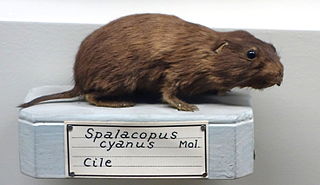
Caviomorpha is the rodent parvorder that unites all New World hystricognaths. It is supported by both fossil and molecular evidence. The Caviomorpha was for a time considered to be a separate order outside the Rodentia, but is now accepted as a genuine part of the rodents. Caviomorphs include the extinct Heptaxodontidae, the extinct Josephoartigasia monesi and extant families of chinchilla rats, hutias, guinea pigs and the capybara, chinchillas and viscachas, tuco-tucos, agoutis, pacas, pacaranas, spiny rats, New World porcupines, coypu and octodonts.

A tuco-tuco is a neotropical rodent in the family Ctenomyidae. Tuco-tucos belong to the only living genus of the family Ctenomyidae, Ctenomys, but they include approximately 60 different species. The common name, "tuco-tuco", comes from the "tuc-tuc" sound they make while they dig their burrows.

Haig's tuco-tuco, known regionally as the Patagonian tuco-tuco, is a hystricognath rodent. Like other tuco-tucos it is subterranean and thus not often observed, although the "tuc-tuc" call of the males can be heard near burrow sites, especially in the early morning. Like most species in the genus Ctenomys, C. haigi are solitary, with one adult per burrow.

The Brazilian tuco-tuco is a tuco-tuco species. It is found mainly in the state of Minas Gerais in southeastern Brazil, though Charles Darwin mentions it during his trip through present-day Uruguay.

The collared tuco-tuco is a tuco-tuco species from South America. It is found in southern Brazil, Uruguay and northern Argentina, where it lives underground in a burrow it digs in savannah habitats. It is a relatively common species and the IUCN has assessed its conservation status as being of "least concern".

The southern tuco-tuco is a species of rodent in the family Ctenomyidae. It is endemic to Argentina.
The reddish tuco-tuco is a species of rodent in the family Ctenomyidae. Five subspecies have been recognized, some formerly designated as separate species. It is found in Argentina and Bolivia at altitudes from 600 to 4,500 m. This tuco-tuco is fossorial, like others in its genus. Its diet consists of underground tubers and roots. Its karyotype has 2n = 52 and FN = 78.
The tawny tuco-tuco is a species of burrowing rodent in the family Ctenomyidae. It is found in the desert regions of northern Chile and adjoining areas of Argentina.
The Maule tuco-tuco is a species of rodent in the family Ctenomyidae. It is found in Argentina and Chile, where it occupies several different types of habitats. It is a common species, and the IUCN has assessed its conservation status as being of "least concern". The common and scientific names refer to a river and region in Chile within its range.
The Mendoza tuco-tuco is a species of rodent in the family Ctenomyidae.

The highland tuco-tuco is a species of rodent in the family Ctenomyidae. It is found in high grassland in Argentina, Bolivia, Chile, and Peru where it lives in burrows.
The San Luis tuco-tuco is a species of rodent in the family Ctenomyidae. It is endemic to Argentina.
The social tuco-tuco is a species of rodent in the family Ctenomyidae. It is endemic to Argentina. Its natural habitat is subtropical or tropical dry lowland grassland.

The robust tuco-tuco is a species of rodent in the family Ctenomyidae. It is a burrowing rodent and is endemic to the Tucumán Province of Argentina.
The mountain viscacha rat or mountain vizcacha rat, historically viscacha rat or vizcacha rat, is a species of rodent in the family Octodontidae. It is endemic to Argentina.

The coruro is a species of rodent in the family Octodontidae. It is the only species in the genus Spalacopus. The species is endemic to central Chile, where it has been found in a wide variety of habitats, from coastal to montane. It is fossorial and lives in colonies.

Flamarion's tuco-tuco or the tuco-tuco of the dunes is a rodent species of the family Ctenomyidae Its karyotype has 2n = 48 and FN = 50–78. It is endemic to the coastal dunes of Rio Grande do Sul state, southern Brazil. The species is threatened by habitat loss due to dune removal and urbanization. It is named after Brazilian biologist Luiz Flamarion B. de Oliveira.
Roig's tuco-tuco is a species of rodent in the family Ctenomyidae. It is endemic to a small region near the Paraná River in Corrientes Province, northeastern Argentina, where lives on sand dunes, and near rivers. Development is degrading and shrinking this habitat, threatening the rodent's survival. The species is named after Argentine zoologist Virgilio G. Roig. Its karyotype has 2n = 48 and FN = 80.
The Ibicui tuco-tuco is a species of rodent in the family Ctenomyidae. It is endemic to southern Brazil.










